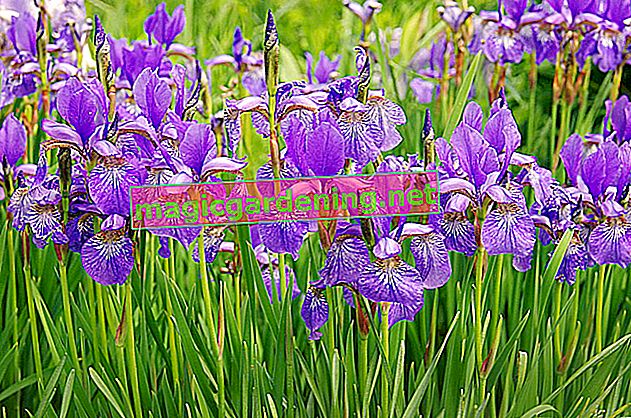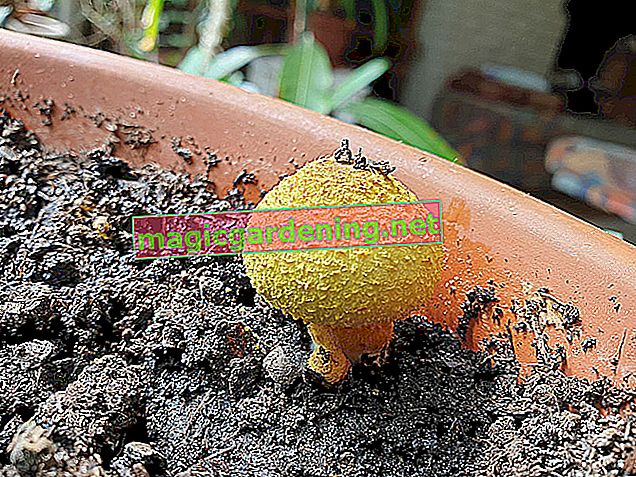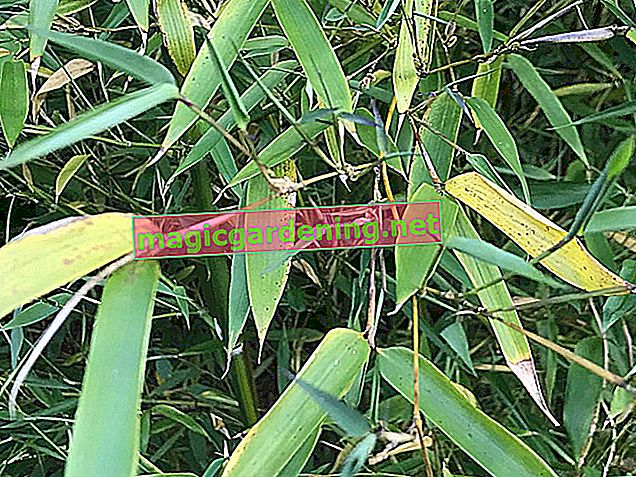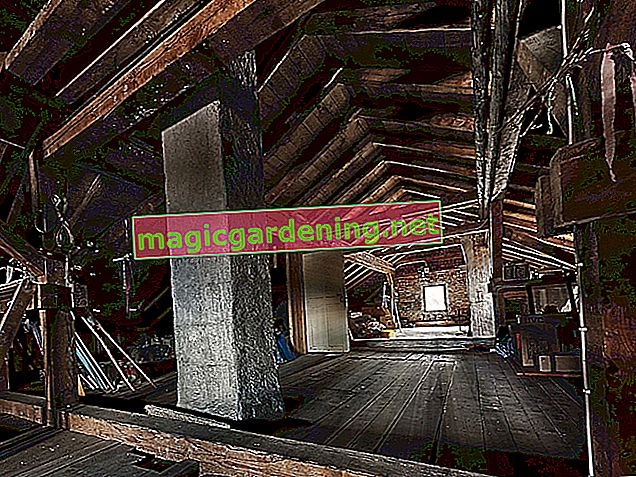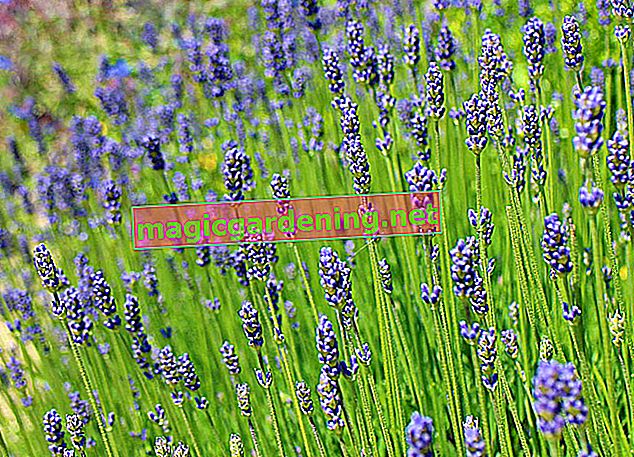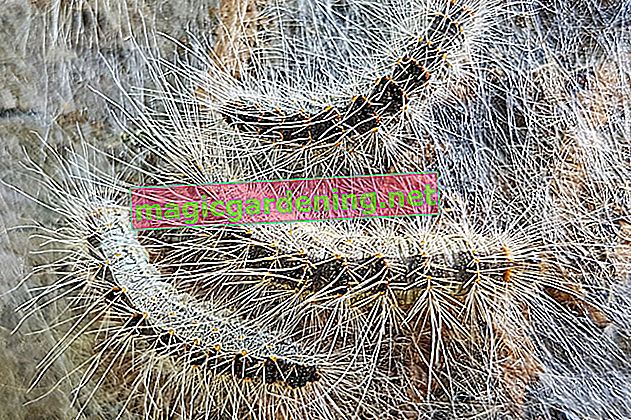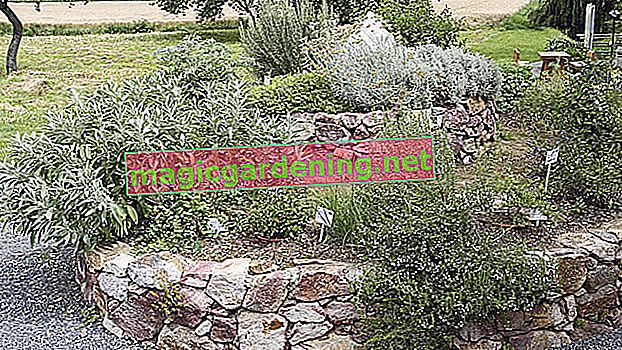
the essentials in brief
- Horn shavings (€ 6.39 at Amazon *) are offered in discounters and hardware stores in bags of 2.5 or 5 kg. Usually the smaller variant is sufficient for one gardening season. There are seldom mixed fertilizers with castor meal.
- The horn fertilizer is suitable for most ornamental and useful plants in the garden. However, these require additional nutrients. Horn shavings are not suitable for indoor plants.
- Horn fertilizers, which are divided into horn meal, semolina and shavings, consist of around 85 percent animal proteins. The nitrogen content is between twelve and 15 percent. Other nutrients are negligible.
- Horn shavings are spread in the growing season until autumn. Good preparation and dosage is essential for optimal results. This is influenced, among other things, by the weather and the condition of the soil.
Buy horn shavings - products in comparison

Horn shavings are an ideal fertilizer. Most of the raw materials are imported from South America. Here the cattle graze on large pastures so that the animals can move around without restriction. In Germany, calves have to be dehorned at an early stage so that they do not injure themselves later in the stalls.
also read
- How to fertilize your garden correctly - tips for the ideal supply of nutrients
- Garden fertilizing - know how
- Properly fertilize blueberries in the garden
Offer in Germany
The manufacturer Oscorna operates a horn mill near Ulm and has made a name for itself as a producer of organic fertilizers. Horn shavings are available in numerous DIY and specialty stores. If you have a large need, you can buy horn shavings in 25 kg bags. Smaller amounts are sufficient for private use.
| Horn shavings from | content | Bio | Price per kilogram | Note |
|---|---|---|---|---|
| Aldi | 2.5 kg | No | 1.52 euros | not permanently on offer |
| Obi | 2.5 kg | Yes | 2.60 euros | Private label |
| Hornbach | 5 kg | No | 1.99 euros | unbranded |
How much horn shavings do I need?
How high your needs are depends on various factors. Each plant has a different nutrient requirement. Heavily consuming vegetables require more nitrogen than flowering ornamental shrubs. The size of the area has a decisive influence on the amount purchased, because the fertilizer requirement is often calculated per square meter.
Quantities for private use
Usually 60 to 120 grams, about two handfuls, are sufficient on an area of 100 x 100 centimeters. If you want to cover an area of 100 square meters, a 2.5 kilogram sack is enough for a little more than one season. You should have larger quantities in stock if you need to top up.
You should pay attention to this when buying
Basically there are no major differences between the individual products from different manufacturers. Mixed products are rarely offered in which the horn shavings (€ 6.39 at Amazon *) have castor meal. It is unknown how common the substance toxic to pets is found in horn fertilizers. Therefore, always pay attention to the contents and avoid the treacherous complete fertilizers.

For which plants are horn shavings suitable?

Horn fertilizer proves to be versatile and can be used in the garden to fertilize almost all plants. The substrate has no influence on the pH value of the soil, so you can also supply lime-sensitive plants such as blueberries or rhododendrons with the nitrogen supplier. The hedge on the edge of the property also enjoys horn chip fertilization.
background
Horn shavings as a universal fertilizer?
Although the organic substrate mainly provides nitrogen, it can be used as a universal fertilizer in most gardens. According to soil analyzes, there is an adequate supply of phosphate and potassium in more than half of all private gardens, although these main nutrients are often too high. The use of complex fertilizers causes these over-supplied soils to become increasingly unbalanced. The result is growth disorders of the cultivated useful and ornamental plants.Are horn chips suitable for the lawn?
Horn shavings can be used as a long-term lawn fertilizer if you consider the delayed effect in your fertilization. You should start well before the new growing season so that the lawn gets a good start to the season. If the grass shows signs of deficiency and the lawn is not growing well, you can give horn meal.
Lawn fertilization schedule:
- regular nitrogen supply necessary
- first fertilization between March and April
- then re-fertilize every six weeks
- From July onwards, do without horn shavings and fertilize with a high concentration of potassium
Fertilize roses - horn shavings for ornamental plants
Like many flowering shrubs, roses have a high requirement for phosphate. The substance promotes flower development and supports the energy metabolism. If you have found out with the help of a soil analysis that the phosphate and potassium content are high enough, you can add horn fertilizer to peonies, oleander or thuja.
- Give horn shavings directly when planting hydrangeas and the like
- then work into the soil at the beginning of each vegetation phase
- Re-fertilization takes place three months later
- Sprinkle horn meal in addition if deficiency symptoms occur
Horn shavings for tomatoes and vegetables
Tomatoes are heavy eaters who have a high need for nutrients throughout their growth phase. Along with phosphate, potassium and magnesium, nitrogen is essential for healthy growth and a rich harvest. In spring, a nitrogen-rich fertilization with horn shavings proves to be useful. If necessary, you can re-fertilize after three months.
Ideally, you should enrich the soil with the organic slow release fertilizer before planting your tomato seedlings. All crops with high nutrient requirements, like cucumbers, can be supplied with nitrogen in this way.
Nitrogen fertilizer for fruit bushes and perennials?
Fruit trees are grateful for an organic slow release fertilizer. However, horn shavings are not enough as the sole fertilizer for many shrubs and perennials such as strawberries or currants. These plants have a high need for potassium. In the spring, provide these plants with a combination of horn manure and compost. Horn shavings are generally well suited for the olive tree. If the planter is in the living room, the substrate can cause odor nuisance.
Unsuitable for indoor plants
Ornamental plants in the kitchen, bathroom and living room should not be fertilized with horn shavings. The material develops an intense odor, which is intensified by adding water. It can quickly smell unpleasant in the entire home. Flowering plants that thrive in pots on balconies and patios can be supplied with horn fertilizer. However, you need to mix the substrate with compost. Horn shavings are broken down by microorganisms in the soil and cannot have any fertilizing effect in depleted potting soil.
What are horn chips made of?

Horn shavings are one of the organic fertilizers that, in contrast to artificially produced mineral fertilizers, do not have any negative environmental effects. The material is considered a secondary raw material fertilizer because it consists of animal waste products such as horn and hooves from slaughtered animals.
Digression
Origin and problems of mineral fertilizers
At the beginning of the 20th century, the chemists Fritz Haber and Carl Bosch developed a process in which, for the first time, large amounts of atmospheric nitrogen were converted into ammonia with the help of heat and pressure. This gaseous substance can then be easily converted into nitrogen compounds such as nitrate or urea. This so-called Haber-Bosch process is considered to be the birth of mineral nitrogen fertilizers.Haber-Bosch process as a curse and a blessing:
- ensures food for the world's population
- Enrichment of nitrogen in nature
- thereby nitrate pollution in drinking water
- increased algal blooms, eutrophication and decline in plant species
ingredients
Horn shavings are considered a supplier of nitrogen, since other nutrients are negligible. Animal proteins make up the bulk of the material. The content of these organic products is around 85 percent. Horn fertilization, however, cannot be used to build up humus in the soil. The protein compounds in which the nitrogen is bound are easily degradable. Hardly any fiber remains and the amounts administered are too small to cause a significant increase in the organic content.
Horn shavings includes:
- Nitrogen : depending on the starting material, between twelve and 15 percent
- Potassium : less than one percent
- Phosphorus : less than one percent
- Other : small amounts of sulfur
One kilogram of horn shavings contains between 100 and 150 grams of nitrogen.
Difference between horn meal, horn shavings and horn semolina
Horn fertilizer is available in different grain sizes. Horn meal is the smallest in size. The particles are less than a millimeter in diameter and therefore decompose the fastest, so that the plants can use the nitrogen within a short time. Horngries is a bit coarser with a grain size between one and five millimeters. Both products are preferred by hobby gardeners, as they develop their fertilizing effect over several weeks.
Horn meal - an intermediate form
There is another intermediate variant between horn semolina and horn shavings. The horn meal contains grains with a size of about five millimeters. Substrates with particles larger than five millimeters are referred to as horn chips. Shot as well as chips develop a long-term effect of up to three months, since it takes the longest to decompose.
Use horn meal or horn shavings?
Which substrate you use for fertilization depends on the desired speed of action. The finer horn meal is more suitable for lawns, as the particles with the irrigation and rainwater get into the soil more quickly and can be broken down there. Horn shavings, on the other hand, remain on the lawn for a long time and disrupt the overall picture. If you are creating a fresh lawn or planting shrubs, perennials and vegetables, horn meal is an ideal long-term fertilizer.
Use horn shavings correctly
In principle, the use of horn chips is simple and involves no major risks. However, there are a few things to keep in mind. Various factors influence the effect of the fertilizer. With the right preparation and a well thought-out approach, you can have a positive influence on the success of fertilization.
When to apply horn shavings

The horn fertilizer can be applied between March and October. The earlier you fertilize, the sooner your plants will benefit from the nutrients available. If you use horn shavings in the autumn after the beds have been harvested, the microorganisms can work until the next spring. In this way, the freshly set plants benefit from available nutrients.
When to fertilize
- first fertilization between March and April
- alternatively, put horn shavings into the planting hole
- Top up in early June
Preparations
Remove all weeds from the area before applying the fertilizing substrate. Horn shavings are not only an ideal nitrogen supplier for useful and ornamental plants, but also provide nutrients for undesired weeds. Above all nitrogen-loving plants such as nettles spread uncontrollably after organic fertilization. When mulching beds, you should mix the material with horn shavings. This way you will prevent too much nitrogen from being drawn out of the soil.
dosage
You can apply horn shavings without the risk of overfertilization. Unlike chemical fertilizers, there is no risk of burning the roots of your plants. This phenomenon often happens when too much salt builds up in the soil due to a lack of water. Horn shavings are a safe form of fertilizer that is dosed differently in different areas of the garden.
| species | How much horn shavings per m2? | Administration with | |
|---|---|---|---|
| Ornamental plants | Hydrangeas, roses and other flowering plants | 30 to 60 grams | sprinkle on the substrate |
| medium-consuming crops | Endive, Swiss chard, beetroot | 30 to 60 grams | a bucket of compost |
| heavily consuming crops | Tomatoes, cabbage, beets | 80 to 100 grams | two buckets of compost |
| Lawns | Sports or ornamental lawn | 30 to 50 grams | sprinkle on the surface |
| Pome fruit | Apples, quinces, pears | 70 to 100 grams | 100 grams of algae lime and three liters of compost |
| Stone fruit | Cherries, peaches, plums | 100 to 130 grams | 100 grams of algae lime and four liters of compost |
| Potted plants | all balcony plants | 10 to 20 grams | one liter of earth |
Top dressing of heavy eaters
This variant is a fertilization with easily soluble and therefore quickly effective nitrogen. Since this is bound by other living beings or plants and can also be washed away by rain, top dressing is recommended as top dressing for heavily eating plants such as tomatoes. Projected over the year, this group of plants can handle five grams of nitrogen per square meter. This amount corresponds to about one tablespoon full of horn meal and is given over four doses.
What to consider:
- horn meal prevents fertilizer from remaining on the leaves
- this will prevent burns
- The first top dressing should be done as soon as the young plants have grown a few centimeters high
- Horn shavings, on the other hand, can be added to the planting hole as a long-term fertilizer
- stop top dressing in good time before the fruits ripen
- Vegetables for storage should not be fertilized for a long time before harvest
commitment
Sprinkle the substrate evenly over the surface by hand or spread the horn fertilizer around the base of the plant. Before sowing, you can sprinkle the substrate on the earth. As with all organic fertilizers, shallow incorporation into the soil is also important for horn shavings. This allows the microorganisms to decompose the substrate optimally. This is necessary in order to make the bound nitrogen available to plants.
Be careful when fertilizing shrubs

In principle, it is advisable to put the slow release fertilizer into the hole before planting. With shrubs, there is a risk that the material will get too deep into the earth. Due to the lack of oxygen, there is less biological activity and the chips are only insufficiently decomposed. To provide hedges and trees with nutrients, you should mix the horn fertilizer with compost and work the substrate into the soil. The compost accelerates the release of nitrogen and provides other important nutrients and trace elements.
Tips
Rake the horn manure into the ground about two inches. This will give you the most efficient fertilizing effect possible.
effect
Since horn shavings are comparatively large, they decompose slowly over a longer period of time. After three months, nitrogen and other nutrients are usually completely released so that they can be absorbed by the plant roots via the soil solution. Over-fertilization is not possible because of the slow effect and the consistently high dosage. The finely ground horn meal, on the other hand, works faster. These organic fertilizers have a neutral pH, which is 7.0.
Tips
Horn shavings promote length growth and are not suitable for Mediterranean herbs such as lavender.
What influences the fertilizer effect
As an organic fertilizer variant, horn shavings depend on the activity of the microorganisms in the substrate. Soil condition and weather have decisive influences on the fertilizer effect. If the soil dries out too much, not only the plants but also the soil organisms suffer. Temperature and ventilation also play a role. During the vegetation phase, the microorganisms in the earth are more active than in winter. They depend on a good soil structure that is adequately ventilated.
Important for high efficiency:
- Loosen the soil well before fertilizing so that aerobic microorganisms can work
- distribute very evenly, use spreading aid for large areas
- Water the substrate well and keep it moderately moist
Due to the factors mentioned, the decomposition takes place over a different period of time, so that an immediate effect is not to be expected. On the other hand, this fertilization is much more sustainable than the input of chemical artificial fertilizers.
Advantages, disadvantages and possibilities
Mineral fertilizers add more and more of the substance to the natural nitrogen cycle. Horn shavings, on the other hand, represent a sustainable and ecological form of fertilizer. The nitrogen resources are recycled and returned to the natural cycle on the way to supplying nutrients. This optimal recycling of biodegradable substances prevents the nitrate content in drinking water from increasing too much or the algae growth in ponds from occurring at an uncontrollable level.
Horn shavings have these disadvantages:
- Origin of the animals for slaughter often unclear
- The addition of “organic” does not guarantee that animals come from organic farming
- cattle often come from factory farming and are supplied with large amounts of antibiotics
- Unilateral nutrient supply to the plants if only horn shavings are used
Make liquid fertilizer
You can dissolve horn shavings in water to provide indoor plants with nitrogen. This method is also suitable for lawns where it is not possible to incorporate the coarse material without damaging the dense vegetation. The liquid fertilizer can be quickly absorbed by the plants.
Preparation:
- Pour one liter of lukewarm water over a handful of shavings
- Let the brew steep in a warm place for about four days
- Sieve and fill into a bottle
- dilute with water before use
frequently asked Questions
Can I drive rabbits away with horn shavings?
Wild rabbits have a fine nose and are deterred by intense smelling scents. Many hobby gardeners swear by horn meal or shavings. The substrate is distributed on the frequently visited areas or directly in the entrances to the rodents' burrows. A good irrigation is necessary, because when wet the substrate gives off a strong aroma.
Do horn shavings help against deer?
For a short time, the intense smell of horn shavings also drives away deer that tamper with the plants in the garden. However, the animals quickly get used to the source of interference and return to the crime scene after a while. In winter, hunger is usually greater than fear anyway, so the deer test how far they can go. You should therefore use different deterrence measures alternately. For example, you can spray flowers and plants with buttermilk.
Are horn shavings useful against clover?
White clover has a big advantage over other plants. The species lives in symbiosis with so-called nodule bacteria, which bind nitrogen from the air and make it available to the plant. This allows clover to prevail over grasses on unfertilized areas. So that the unwanted weeds are slowly pushed back, you have to encourage the growth of the grasses:
- Long-term fertilizers such as horn shavings are unsuitable as an immediate measure
- better to use a direct-acting nitrogen fertilizer
- Ideally, fertilize the lawn regularly in March, June and September
Another reason for excessive clover growth can be an elevated pH level, at which grasses no longer thrive. Lawn needs a pH between 6.0 and 6.5. With the help of a soil analysis you can determine in which area the value of your lawn lies.
Are horn chips poisonous?
In principle, horn fertilizer is not toxic to dogs, cats or children. Dogs like the special smell given off by the protein-rich granules. They like to dig in the fertilized beds and eat the crumbs. However, the substrate is not popular with some dog owners. The reason for this are admixtures that are found in some horn chip products. In order to turn the one-sided nutrient supplier into a complete fertilizer, castor meal is occasionally added. This can lead to vomiting and bloody diarrhea in dogs.
Can horn shavings transmit BSE?
Plants are not able to absorb whole proteins like the BSE pathogen. In order for this to get into the human organism, the protein would have to survive for months and pass into the diet with crumbs of earth adhering to the plants. This case is extremely unlikely. In addition, according to statements by the EU Commission, horn shavings are considered harmless with regard to BSE. The horn and hooves from which the fertilizer is obtained do not contain any nerve tissue and are therefore not suspicious sources of transmission.
Can I fertilize wine with horn shavings?
Nitrogen is of central importance in the metabolism of the grapevine and has a major influence on growth and fruit development. The nutrient is found in the soil in various forms. Since only one to four percent of the bound nitrogen is released annually by microorganisms, an additional supply of horn shavings is recommended.


